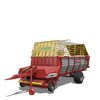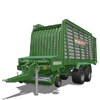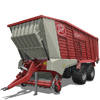Loading Wagons/Farming Simulator 17
A Loading Wagon (or Forage Wagon) is a type of Container in Farming Simulator 17. It can only be filled with a limited variety of materials related to Animal Husbandry and the production of Silage. The main advantage of a Loading Wagon is that it can collect its own material straight from Piles on the ground, without the need for any third-part tools.
A Loading Wagon looks and works very similar to a Tipper, with the exception of a wheeled device at the front (called a "Pickup Head") that can be lowered to the ground and activated. When active, the Pickup Head will automatically suck in any Piles it encounters, as long as they are of a valid material type. Loading Wagons can pick up and hold Grass, Hay, Straw. Despite also being able to carry Chaff and Silage, they cannot pick those materials up from the ground.
Loading Wagons are used to quickly collect a large quantity of materials, particularly after mowing Grass or after a Harvester has created a swath of Straw. To speed up the loading process, it is possible to use a Windrower to arrange the material in thin straight lines for the Loading Wagon to pick up in a single pass.
Farming Simulator 17 offers 4 models of Loading Wagons. They differ from one another in Price, Capacity, and Weight. Additionally, there are small differences in Horsepower Consumption and Work Width, which have a minor impact on effectiveness. Loading Wagons also compete with Forage Harvester Pickup Headers, which can perform a similar task.
List of Loading Wagons
Below is a list of all 4 models of Loading Wagons found in Farming Simulator 17. They can all be found in the "Loading Wagons" category at the store.
| Name | Price | Maint. Cost per Day |
Capacity | Empty Weight |
Working Width |
Front Hitch |
|---|---|---|---|---|---|---|
| Pöttinger Euroboss 330 T | 31,000 | 30 | 21,300 | 3,003 | 2.4 | Drawbar (Bolt) |
| Bergmann REPEX 34S | 68,000 | 60 | 34,000 | 8,075 | 2.4 | Drawbar (Ball) |
| Lely Tigo XR 75 D | 112,000 | 90 | 44,000 | 10,318 | 2.6 | Drawbar (Ball) |
| Strautmann Tera-Vitesse CFS 5201 DO | 131,000 | 110 | 50,000 | 13,244 | 2.6 | Drawbar (Ball) |
List of Valid Cargo Types
Loading Wagons can only carry a limited variety of cargo types:
Of these, a Loading Wagon can only pick up Grass, Hay and Straw, using its automated pickup header. It cannot pick up Chaff or Silage that are already on the ground - those must be picked up and dumped into it by another machine (e.g. a Loader with a Bucket).
Loading a Wagon
- Main article: Loading Containers
Loading Wagons can be loaded "normally" by dumping cargo into them from another machine or storage facility.
Additionally, and more importantly, Loading Wagons can load themselves. They do so by picking up materials straight from Piles left on the ground by other machines, particularly Mowers and Harvesters.
Normal Container Loading
Loading Wagons are very similar to all other Containers, and can be loaded in most of the ways described in the article on Containers.
Note that some of the methods in that article are not applicable to Loading Wagons due to the limited types of cargo they can carry. For example, Loading Wagons cannot be used with Harvesters, since they cannot carry any Crop materials.
Pickup Loading
The main advantage of a Loading Wagon is that it can pick up materials straight from the field, after they had been dumped there previously by another vehicle. It can only pick up Piles of Grass, Hay, and Straw.
To pick up any cargo, the Loading Wagon's pickup head must be activated and lowered to the ground. While working, the pickup head will automatically suck in any Pile it touches, as long as the Pile contains materials of the valid types listed above. It must still conform to the rules laid out in the article on Loading Containers, of course.
One use of this function is to pick up Grass after it has been mowed (or Hay, if the grass had been processed with a Tedder after mowing). Mowers leave trails of grass on the field, which the Loading Wagon can be dragged over. Note that Mowers tend to leave a lot of mess in their wake, so it is generally better to use a Windrower on the field first, to arrange the grass/hay into neat lines. This will mean fewer passes with the Loading Wagon to collect everything.
Straw is left behind a Harvester when it cuts Wheat or Barley (assuming you have the "Create Straw Swath" option turned on for that harvester). As with Grass (see prev. paragraph), Straw is left in long lines behind the harvester, and a Loading Wagon can be dragged over those lines to pick up the material. Straw Swaths tend to be neatly-arranged and well-spaced (especially when using a larger Harvester), so they don't typically need to be Windrowed before pickup.
Despite the fact that it can also carry Chaff and Silage, a Loading Wagon cannot pick them up from the ground. These materials must be dumped into the Loading Wagon, as though it were a Tipper.
Towing a Wagon
Loading Wagons tend to be a little heavier than comparatively-sized Tippers. This means that you need a somewhat stronger Tractor or other vehicle to tow them. However, because the types of cargo a Loading Wagon can carry (esp. Grass, Hay and Straw) are very light, a full Loading Wagon is typically not much heavier than an empty one. As a result, a Medium Tractor should be able to tow a Loading Wagon of any size with some comfort.
Of course, Loading Wagons are not simple trailers - you'll probably want to activate the pickup head at some point to pick up materials from the field. This requires a power transfer from the towing vehicle to the Loading Wagon. Only certain types of vehicles in the game can provide power to a trailer, including Tractors and several small varieties of Harvesters. Other vehicles, such as Trucks, can tow the Loading Wagon but cannot activate it.
While the pickup head is active, the Loading Wagon pulls some Horsepower from the towing vehicle, weakening it. The larger the wagon, the more power it draws. As a result, a Medium Tractor that might be able to tow a full Loading Wagon comfortably may not be able to tow it as comfortably while the pickup header is activated. If you're using a large Loading Wagon, consider getting a Large-class Tractor to pull it while it's working.
Loading Straw behind a Harvester
A few of the smaller Harvester models can tow a Loading Wagon and provide it with power to use the pickup header. This allows the harvester to pick up its own Straw Swath, removing the need to make a second pass after the harvest to collect all the straw that's been left behind. This can save a lot of time and effort.
In the base game, most harvesters can tow a Loading Wagon, but only the Sampo Rosenlew Comia C6 and New Holland TC5.90 have the ability to give it power. These are very small harvesters, however, and do not have a lot of power to give. If the Harvester is also fitted with a large and power-hungry Harvesting Header, it might not have enough power left to both tow and operate the Loading Wagon. In such an event, the harvester will become sluggish or even immobile.
Therefore, when using a Loading Wagon behind your harvester, make sure to get the smallest wagon model for the job, and the smallest Header you can reasonably use without running out of Horsepower.
When done correctly, this setup can save you a lot of time, and increase the profits from any Wheat or Barley harvest by a few thousand dollars (or alternatively, provide you with ample Straw for other purposes).
Unloading a Wagon
- Main article: Unloading Containers
Loading Wagons are capable of dumping their own cargo out - there is no need (or ability) for any other machine to unload them. Dumping is the only way to unload a Loading Wagon.
In Farming Simulator 17, other than driving a Loading Wagon to a designated unloading spot like a Barn or Feeding Trough to be unloaded, you can also dump the cargo directly on the ground to create a Pile of material. This is also the method used when dumping Chaff and Grass into Silage Bunkers.
For more details about dumping, read the article on Containers.
Comparison with Pickup Headers
A Tractor using a Loading Wagon is functionally very similar to a Forage Harvester using a Pickup Header. Both machines can pick up Grass and Hay straight from the ground into a container.
Despite the similarity, there are a few minor differences between these two methods that can give an advantage to one or the other. Both methods might be useful to you, in different situations.
Loading Wagon Advantages
- Cheaper: To use a Pickup Header, you need to buy the header itself, a Forage Harvester to operate it, and a container to hold the materials. A Loading Wagon, on the other hand, can be operated by most vehicles - particularly Tractors - and you probably already have at least one. This makes the Loading Wagon option significantly cheaper.
- Can Cut Grass: With a Loading Wagon attached to the rear of your Tractor, you can simply attach a Mower in the front and cut the Grass for the Loading Wagon to collect immediately behind you. This sort of combination is not possible at all with a Forage Harvester / Pickup Header.
Pickup Header Advantages
- Slightly Wider: The Working Width of all Pickup Header models in the game are between 3.0 and 3.1 meters, while Loading Wagons have a Working Width of only 2.4 to 2.6 meters. This is an advantage of at least 20%. It might not sound like much, but a little extra width can help when picking up material that isn't perfectly arranged in a neat line.
- Can fill Tippers: A Forage Harvester can tow any type of container behind it. Therefore, unlike a Loading Wagon (which fills itself), it can fill a Tipper, or even a train of Tippers. Some tipper models are quite larger than any Loading Wagon, allowing you to pick up a lot more Grass or Hay in one go before your container fills up.
- Better Precision: Since a Pickup Header is mounted on the front of a Forage Harvester, it is easy to control what you pick up, and easy to back up and clear "that one last bit". Loading Wagons, on the other hand, are attached to the back of a Tractor - it is much harder to control where the Loading Wagon's working head will go, easier to "miss a spot", and much harder to reverse and clean up any missed spots.
| Loading Wagons in Farming Simulator 17 | |
|---|---|
| 2x2 | |
| 4x4 | |
| 6x6 | |




